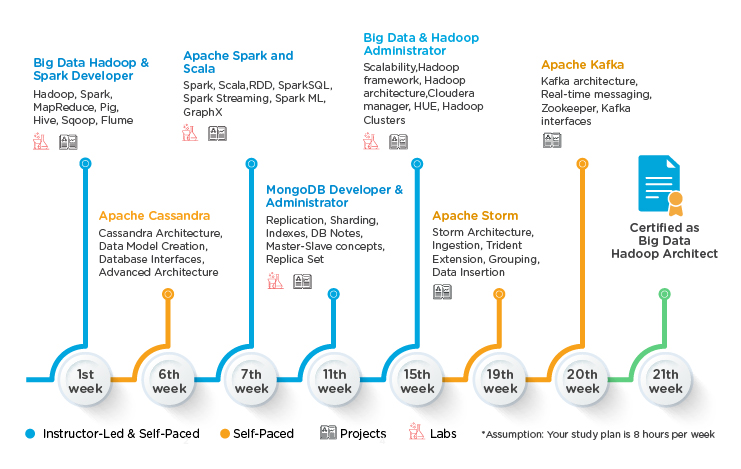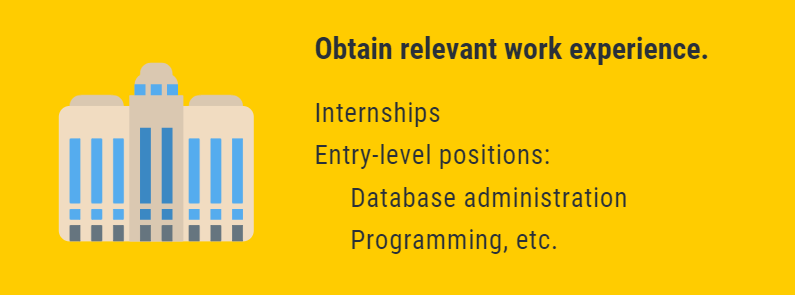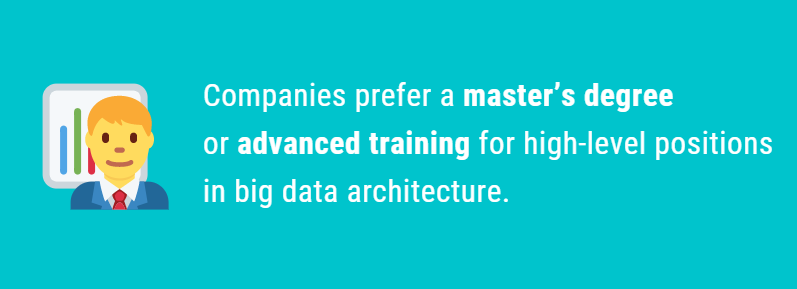
Let me guess: You’re thinking of becoming a big data architect, aren’t you?
That’s a great idea.
If volumes of data and their framework intrigues you, then big data architecture sounds like a fitting assignment for you.
Industries and companies across different sectors are keen on leveraging data to increase their revenue and grow their business. If you were to become a big data architect, then you’d be in a very good position to help them.
If you are serious about becoming a big data architect, then allow me to share with you these crucial points.
1. Pursue a suitable bachelor’s degree.
Your first step to becoming a big data architect is to pursue a relevant undergraduate degree.
That may be information technology, computer engineering, computer science, or a similar field.
Your academic curriculum should cover big data developments, application design, programming, data management, web development, operating systems, technology architectures, and systems analysis, among others.
These subjects are crucial in building your background knowledge and skills in big data architecture.
2. Hone your skills in big data.
To excel in becoming a big data architect, you need to hone both the soft and hard skills required for the job.
As a big data architect, you are seen as someone that’s heavily trained, able to work with profoundly distinct data, and well-versed in multiple programming languages and related technologies.
These technologies and hard skills include the following:
- Information management and data processing on multiple platforms
- Operating systems, plus MS Windows, Linux, UNIX, and Solaris
- Enterprise application integration software such as XML
- Programming languages, specifically Java and Python, including Perl and C/C++
- Development environment software
- Data visualization and data migration
- BI visualization tools like Tableau, R Studio, Apache Zeppelin
- Applied math and statistics
- UML
- Application server software, especially Oracle
- Predictive modeling, text analysis, and NLP
- Archival/backup software
- ETL tools
- Data mining
- Databases like cloud computing and NoSQL
- Database management system software, like Microsoft SQL Server
- ERP implementation and agile methodologies
- Data modeling tools, like Impala, Zookeeper, Flume, Mahoot, Sqoop, Enterprise Architect, Visio, and ERWin
- Data warehouse technologies such as Cassandra, Hadoop, MapReduce, Accumulo, MongoDB, Redshift architecture, Hive
- Foundational database skills, or RDMSs (relational database management systems)
- Machine learning

Besides technological know-how, you need to have astute business and marketing insight. This lets you assess your industry’s big data and support your company executives.
Outstanding communication prowess is also necessary when working with collaborating with colleagues and relaying findings and solutions to audiences with no technical background.
It helps if you have an acute eye for detail as well because any coding issues may require the company millions of dollars to fix.
Teamwork and leadership skills are essential as big data architects usually lead project implementation.
Resourcefulness and innovative problem-solving are integral, too, in creating new solutions and as technologies progress.
Lastly, you must have in-depth knowledge of your industry, big data top trends, and best methods for data collection, organization, storage, and analysis.
3. Obtain relevant experience in applying your skills.
Big data architecture doesn’t typically come as an entry-level position.
As such, it’s best if you first obtain as much relevant experience as early as you can.
Doing so lets you hone your skills further and eventually land you a job in big data architecture.
You can apply for internships at companies in the field of information technology (IT) where you can exercise practical skills applications in the industry, and develop professionalism.
Before becoming a big data architect, you may also need three to five years’ work experience at IT and similar companies with demonstrated excellent project implementation.
You can first take on entry-level positions in database administration or programming.

In your internship and work experience, aim to develop yourself in network management, performance management, and application architecture.
Then, continue improving your skills in development management, database design, warehousing, and modeling.
4. Garner Master’s degree and professional certifications.
There are other avenues for you to enhance your expertise and build on your credibility as a big data architect.
Consider pursuing advanced certification in big data courses and garner professional certifications for completing them.
In these courses, you will acquire insights on using big data platforms to increase your business or industry productivity.

You will gain a solid understanding and dexterity for big data technologies and tools for data collection and storage and advanced analytics.
These courses even provide projects and eye-opening practical applications with mentorship.
Keep in mind that companies usually prefer a master’s degree or advanced training for high-level positions in big data architecture.
Garnering these competencies, hence, will be advantageous when you pursue becoming a big data architect.
5. Work as a big data architect.
With your extensive training and years of work experience, you can then begin working as a big data architect.
If you’re running an ecommerce business (or other types of businesses), you can apply your big data architecture knowledge and competence there.
You can also work with other businesses and sectors, like finance, healthcare and insurance, education, and other entities that handle massive amounts of data.
You can also become a big data architect in software and computer-manufacturing corporations.
Being a big data architect, you will have these responsibilities:
- Correspond with various industry stakeholders and representatives for needs and goals assessment
- Review present databases and big data architecture
- Organize an end-to-end system for consuming and analyzing data
- Code new big data architecture and consolidate current databases
- Apply best ETL (extract, transform, load) practices for generating new databases
- Research and uncover different data acquisition procedures
- Track databases, report on their accuracy and efficacy and update them whenever necessary
- Formulate protocols on and maintain database security
- Keep and safeguard an archive of big data architecture products.
You, as the big data architect, are in charge of designing blueprints or models for data management structures.
You evaluate possible internal and external data sources and devise a plan to incorporate, streamline, secure, and preserve them.
Doing so helps employees in your company to know where to access vital information when they need it.
You also help the company perceive its critical goals in light of managing big data. You collaborate with data engineers and software designers in planning for database consolidation.
You also get to produce innovative platforms that are functional for your target audience.
Finally, you will have the task of plotting database updates and enhancements, so they bring optimal and maximum results to the company.
As such, be prepared to extend your working hours, even on weekends, if necessary, to finish updates and projects on schedule.
Be a big data architect.
Becoming a big data architect is rewarding, both professionally and financially. Aspiring big data architects like you will soon find that to be true.
Every day, you will encounter opportunities to conquer mind-boggling challenges, modernize big data architecture, and better not only your company but also the society and the world.
Was this guide beneficial to you? Hit the share button and be the first to post this. Cheers!
